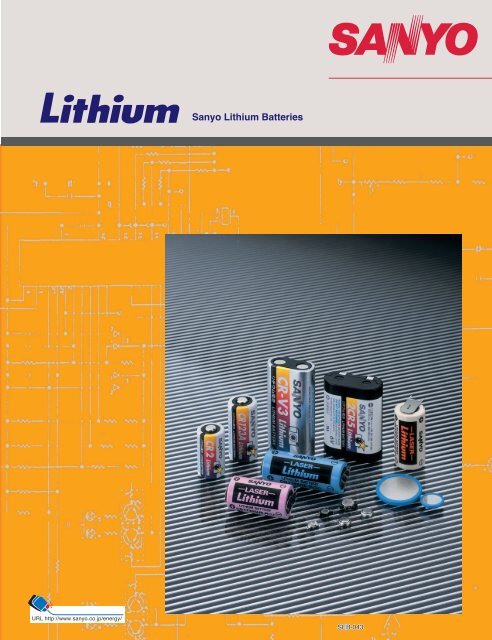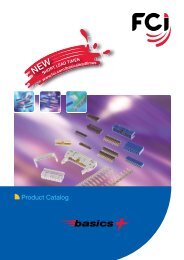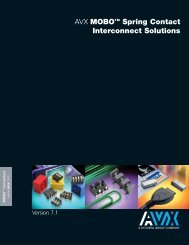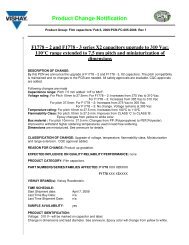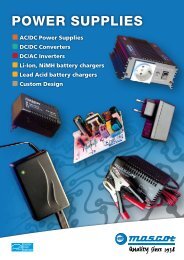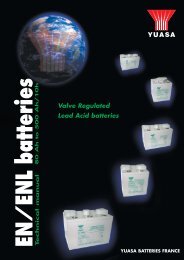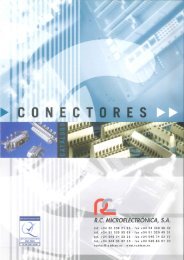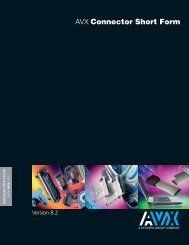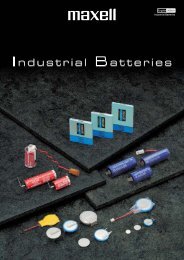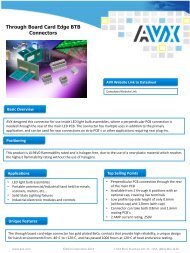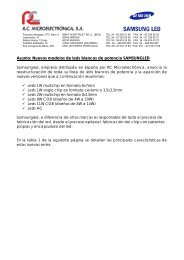Sanyo Lithium Batteries
Sanyo Lithium Batteries
Sanyo Lithium Batteries
You also want an ePaper? Increase the reach of your titles
YUMPU automatically turns print PDFs into web optimized ePapers that Google loves.
<strong>Sanyo</strong> <strong>Lithium</strong> <strong>Batteries</strong><br />
URL http://www.sanyo.co.jp/energy/<br />
SEB-043
Battery Handling Precautions for Your Own Safety<br />
<strong>Lithium</strong> batteries contain combustible materials such as lithium metal and organic solvent. Improper handling can lead to<br />
heat generation, bursting or fire. To prevent accidents, follow these precautions and refer to them when precautions<br />
regarding lithium battery usage are described in instruction manuals for equipment you are using.<br />
Coin-type Primary and Rechargeable <strong>Lithium</strong> <strong>Batteries</strong><br />
WARNING!<br />
1. Do not charge.<br />
(Primary batteries, CR series).<br />
When this battery is charged, gas is generated inside and raises<br />
internal pressure, resulting in fire, heat generation, leakage or<br />
bursting.<br />
2. Do not heat, disassemble nor dispose of<br />
in fire.<br />
Doing so damages the insulation materials, resulting in fire, heat<br />
generation, leakage or bursting.<br />
3. Do not insert batteries with the + and --<br />
polarities reversed.<br />
Make sure the polarities are in the right position when inserting the<br />
batteries into equipment. When using 3 or more batteries, the<br />
equipment may operate even though one of the batteries is<br />
improperly inserted. But this may cause leakage or bursting.<br />
4. Do not short-circuit.<br />
If the + and -- come into contact with metal objects, short circuiting<br />
occurs resulting in heat generation or bursting. When carrying or<br />
storing batteries, avoid direct contact with metal objects such as<br />
bracelets or key chains by putting them in a separate bag.<br />
5. Keep batteries out of children's reach.<br />
If leaked liquid is ingested or a battery is swallowed, consult a<br />
physician immediately.<br />
6. In case of leakage or a strange smell,<br />
keep away from fire to prevent ignition of<br />
any leaked electrolyte.<br />
7. Do not solder directly.<br />
This can damage the insulation materials, resulting in fire, heat<br />
generation, leakage or bursting.<br />
CAUTION!<br />
1. If leaked liquid gets in the eyes, wash<br />
them with clean water and consult a<br />
physician immediately.<br />
2. Do not use new and used batteries<br />
together. Do not use different types of<br />
batteries together.<br />
Doing so may cause heat generation, leakage or bursting.<br />
3. Do not apply strong pressure to the<br />
batteries nor handle roughly.<br />
Doing so may cause heat generation, leakage or bursting.<br />
4. Do not use nor leave the batteries in<br />
direct sunlight nor in high-temperature<br />
areas.<br />
Doing so may cause heat generation, leakage or bursting.<br />
5. Avoid contact with water.<br />
Doing so may cause heat generation.<br />
6. Make sure to insert batteries without<br />
having the + and -- come in contact<br />
with metal parts of equipment.<br />
7. Read the equipment instruction manual<br />
and precautions carefully before use.<br />
Some usages or types of equipment do<br />
not suit the specifications or performance<br />
of these batteries.<br />
8. Keep batteries away from direct sunlight,<br />
high temperature and humidity.<br />
Leaving batteries in such places may cause heat generation.<br />
9. For proper disposal, follow local<br />
government regulations.<br />
8. Be sure to wrap each battery when<br />
disposing or storing to avoid short sircuit.<br />
Putting batteries together or in contact with metal objects causes<br />
short circuiting, resulting in fire, heat generation or bursting.<br />
9. Do not force-discharge.<br />
When a battery is force-discharged by an external power source, the<br />
voltage drops to 0 or less (reversal voltage) and gas is generated<br />
inside the battery. This may cause fire, heat generation, leakage or<br />
bursting.<br />
10. Do not charge with high current and high<br />
voltage.<br />
(Rechargeable batteries, ML, NBL series).<br />
Doing so may generate gas inside the battery, resulting in swelling,<br />
fire, heat generation or bursting.
Cylindrical-type Primary <strong>Lithium</strong> <strong>Batteries</strong><br />
"DO NOT CHARGE"<br />
WARNING!<br />
1. Do not use batteries for unspecified<br />
purposes.<br />
Differences in voltage or terminal configuration may cause an<br />
imperfect connection, fire, heat generation, leakage or bursting.<br />
2. Do not charge.<br />
When this battery is charged, gas is generated inside and raises<br />
internal pressure, resulting in fire, heat generation, leakage or bursting.<br />
3. Do not heat, disassemble nor dispose of<br />
in fire.<br />
Doing so damages the insulation materials or the gas release vent,<br />
resulting in fire, heat generation, leakage or bursting.<br />
4. Do not insert batteries with the + and --<br />
polarities reversed.<br />
Make sure the polarities are in the right position when inserting the<br />
batteries into equipment. When using 3 or more batteries, the<br />
equipment may operate even though one of the batteries is<br />
improperly inserted. But this may cause leakage or bursting.<br />
5. Do not short-circuit.<br />
If the + and -- come into contact with metal objects, short circuiting<br />
occurs resulting in heat generation or bursting. When carrying or<br />
storing batteries, avoid direct contact with metal objects such as<br />
bracelets or key chains by putting them in a separate bag.<br />
6. Keep batteries out of children's reach.<br />
If leaked liquid is ingested or a battery is swallowed, consult a<br />
physician immediately.<br />
7. In case of leakage or a strange smell,<br />
keep away from fire to prevent ignition of<br />
any leaked electrolyte.<br />
8. Do not use new and used batteries<br />
together. Do not use different types of<br />
batteries together.<br />
Doing so may cause fire, heat generation, leakage or bursting.<br />
9. Do not solder directly.<br />
Doing so may cause damage to insulation materials. It may also<br />
cause fire, heat generation, leakage or bursting.<br />
10. Do not apply strong pressure nor handle<br />
roughly.<br />
Doing so may cause fire, heat generation, leakage or bursting.<br />
11. To prevent damage to the gas release vent<br />
inside<br />
the battery, do not deform in any way.<br />
12. Do not force-discharge.<br />
When a battery is force-discharged by an external power source, the<br />
voltage drops to 0 or less (reversal voltage) and gas is generated<br />
inside the battery. This may cause fire, heat generation, leakage or<br />
bursting.<br />
13. Do not damage nor peel off the resin film<br />
on the surface of the battery.<br />
CAUTION!<br />
1. If leaked liquid gets in the eyes, wash<br />
them with clean water and consult a<br />
physician immediately.<br />
2. Do not use nor leave the batteries in<br />
direct sunlight nor in high-temperature<br />
areas.<br />
Doing so may cause heat generation, leakage or bursting.<br />
3. Avoid contact with water.<br />
This can cause heat generation.<br />
4. Read the equipment instruction manual<br />
and precautions carefully before use.<br />
Some usages or types of equipment do<br />
not suit the specifications or performance<br />
of these batteries.<br />
5. Keep batteries away from direct sunlight,<br />
high temperature and humidity.<br />
Leaving batteries in such places may cause heat generation.<br />
6. Be sure to wrap each battery when<br />
disposing or storing to avoid short sircuit.<br />
Putting batteries together or in contact with metal objects causes<br />
short circuiting, resulting in fire, heat generation or bursting.<br />
7. For disposal, follow local government<br />
Precautions for Designing Equipment<br />
For further information, refer to the Connection Terminal Specifications for <strong>Lithium</strong><br />
<strong>Batteries</strong> and Key Circuit Design Points which is available upon request.
Featuring compact dimensions, high energy<br />
capacity and long-term durability,lithium<br />
batteries successfully meet today's needs.<br />
Connection Terminal Specifications<br />
<strong>Sanyo</strong> meets various user requirements by developing an extended line of batteries with different terminal designs (tabs, connectors and other terminals) as well as<br />
various battery holders. Regarding standard specifications and key circuit design points, see the separately provided "Connection Terminal Specifications for <strong>Lithium</strong><br />
<strong>Batteries</strong> and Key Circuit Design Points."<br />
International Transportation<br />
Regulations for international transportation of lithium batteries may be largely classified into four categories.<br />
1. Air Transport<br />
Based on DGR (Dangerous Goods Regulations) of ICAO (International Civil Aviation Organization), IATA (International Air Transport Association) has determined<br />
transport regulations. The regulation states that lithium batteries are considered not dangerous if they meet the following requiremints:<br />
Each bare cell with a solid cathode must contain 1.0g (Assembled battery using more than 2 cells must contain 2.0g) or less of lithium or lithium alloy. (<strong>Sanyo</strong>’s<br />
lithium batteries are all solid cathodes.)<br />
They may be transported in rigid packaging with short-circuit protection.<br />
2. Marine Transport<br />
IMO (International Marine Organization) has determined transport regulations based on IMDG (International Marine Dangerous Goods). The judgement standard of<br />
dangerous goods is based on DGR of ICAO. When the batteries are not regarded as dangerous goods, they should be transported in rigid packaging with short<br />
circuit protection, according to IATA standards.<br />
3.<br />
DOT (Department of Transportation)<br />
Regulations for packaging and transportation of lithium batteries in the U.S.A. are determined by Code 49 CFR173. 185 of Federal Register.<br />
The judgement standard of dangerous goods corresponds to DGR of ICAO. When the batteries are not regarded as dangerous, any transportation method is<br />
acceptable if they are transported in rigid packaging with short circuit protection.<br />
The following <strong>Sanyo</strong> lithium batteries contain less than 1.0g of lithium or lithium alloy (under 2.0g for assembled batteries) per single cell.<br />
CR1220, CR2016, CR2025, CR2032, CR2430, CR2450, CR-1/3N, 2CR-1/3N, CR17335E-R, CR17335HE-R, CR17450E-R, CR17450E-N, CR2, CR123A,<br />
CR-P2, 2CR5, CR-V3, CR14250SE, CR12600SE, CR17335SE, CR17450SE<br />
Rechargeable <strong>Lithium</strong> <strong>Batteries</strong><br />
ML414U, ML421, ML614, ML621, ML1220, ML2016, ML2430, UT614, UT621, NBL414, TL421, ML410R/RU, ML414RU, ML614R, NBL414R, TL414R<br />
4. Perchlorate Best Management Practices Regulation of California in the U.S.<br />
Primary lithium batteries described below fall under perchlorate best management practices regulation of California in the U.S..<br />
CR1220,CR2016,CR2025,CR2032,CR2430,CR2450,CR14250SE,CR12600SE,CR17335SE,CR17450SE<br />
Consult us regarding the detail.<br />
Disposal
Sizes and Models of <strong>Lithium</strong> <strong>Batteries</strong><br />
<strong>Sanyo</strong> lithium battery dimensions and models are as follows:<br />
Coin Type <strong>Lithium</strong> <strong>Batteries</strong><br />
<br />
<br />
<br />
<br />
<br />
<br />
<br />
<br />
<br />
<br />
<br />
<br />
<br />
<br />
<br />
<br />
<br />
<br />
<br />
<br />
<br />
<br />
<br />
<br />
<br />
<br />
<br />
<br />
<br />
<br />
<br />
<br />
<br />
<br />
<br />
<br />
<br />
<br />
Cylindrical Type Primary <strong>Lithium</strong> <strong>Batteries</strong><br />
<br />
Model numbers are based on a code, as shown by the following examples:<br />
<br />
<br />
<br />
<br />
<br />
<br />
<br />
Example 1 Example 2 Example 3 Example 4<br />
height (2.5mm)<br />
diameter (20.0mm)<br />
height (1/3 of N size)<br />
for connection in series (2)<br />
R : rupture vent<br />
N : notch vent<br />
shape (round)<br />
laser-welding<br />
type<br />
height (45.0mm)<br />
manganese dioxide/<br />
diameter (17.0mm)<br />
primary lithium battery<br />
<br />
CR20 25 2 CR -1/3N CR 17 450 E-R CR 17 335 S E<br />
<br />
<br />
<br />
(unit : mm)<br />
<br />
<br />
<br />
<br />
<br />
<br />
<br />
(unit : mm)<br />
laser-welding<br />
bobbin structure<br />
height (33.5mm)<br />
diameter (17.0mm)<br />
Example 5<br />
ML410R U<br />
high capacity type<br />
reflowable<br />
ML : Manganese Rechargeable <strong>Lithium</strong> <strong>Batteries</strong><br />
UT : Cobalt Titanium Rechargeable <strong>Lithium</strong> Battery<br />
NBL : Niobium Rechargeable <strong>Lithium</strong> Battery<br />
TL : Titanium Rechargeable <strong>Lithium</strong> Battery
Manganese Dioxide Primary <strong>Lithium</strong> <strong>Batteries</strong> (CR series)<br />
Primary <strong>Lithium</strong> <strong>Batteries</strong><br />
<strong>Sanyo</strong> manganese dioxide primary lithium batteries, developed in 1976, feature high energy density.<br />
Because they offer many unique features not found in either convetional dry cells or silver oxide<br />
batteries, <strong>Sanyo</strong> lithium batteries are currently used in a wide range of equipment such as electronic<br />
calculators, watches and cameras. In addition, they are used as a memory backup power source in<br />
microcomputer-controlled devices. By offering a wide range of lithium batteries, from coin cells to<br />
high-power cylindrical type cells (spiral structure) and high-capacity cylindrical type cells (bobbin<br />
structure), <strong>Sanyo</strong> has been able to meet the demands of a large and diversified market.<br />
<strong>Sanyo</strong> is acquiring International Regulation ISO9001 approval which is a quality guarantee. <strong>Sanyo</strong><br />
continues to implement thorough quality control.<br />
Principles and Structure of Primary <strong>Lithium</strong> <strong>Batteries</strong><br />
Applying an original manufacturing process, <strong>Sanyo</strong> uses a manganese dioxide compound as the active material for the positive electrode<br />
(cathode). <strong>Lithium</strong> is used for the negative electrode (anode) to produce a cell with high voltage and high energy density. In addition, an<br />
organic electrolyte is employed to which lithium salts are added.<br />
The discharge reaction of lithium batteries is as follows:<br />
Anode reaction: LiLi e <br />
The cell voltage is approximately 3V.<br />
Cathode reaction: Mn O2Li e Mn O2 (Li )<br />
Overall battery reaction: Mn O2LiMn O2 (Li )<br />
Battery Structure<br />
High-power cylindrical type lithium batteries are capable of<br />
producing a very high discharge current due to their spiral electrode<br />
structure. High-capacity cylindrical type lithium batteries have a<br />
bobbin structure which contains active material and can provide a<br />
high capacity.<br />
In addition, the laser sealing technology ensures long-term<br />
reliability and a battery life of up to 10 years at room temperature.<br />
Coin Type Primary <strong>Lithium</strong> <strong>Batteries</strong> (crimp-sealing)<br />
<br />
<br />
<br />
<br />
<br />
<br />
Cylindrical Type Primary <strong>Lithium</strong> <strong>Batteries</strong><br />
Crimp-sealing<br />
High-power (spiral structure)<br />
Laser-sealing<br />
Notch vent<br />
Rupture vent<br />
High-capacity (bobbin structure)<br />
Laser-sealing
Features of Primary <strong>Lithium</strong> <strong>Batteries</strong><br />
Stable Operating Voltage of 3V<br />
Nominal Voltage of Major <strong>Batteries</strong><br />
<strong>Lithium</strong> batteries have a high discharge voltage of 3 volts. Thus<br />
a single lithium battery can be used to replace two or three<br />
conventional silver oxide or manganese batteries (1.5V). The<br />
stable operating voltage over as long as 10 years, at room<br />
temperature, ensures outstanding performance, quality and<br />
reliability.<br />
<br />
<br />
<br />
<br />
<br />
<br />
<br />
<br />
<br />
<br />
<br />
<br />
<br />
<br />
<br />
<br />
<br />
<br />
Primary <strong>Lithium</strong> <strong>Batteries</strong><br />
More Than 95% of Initial Capacity Even After 10 Years<br />
A stable electrolyte, <strong>Sanyo</strong>'s superior manufacturing methods<br />
and sealing technology combine to ensure that the tendency of<br />
lithium batteries to self-discharge is reduced to a very low level.<br />
Even after 10 years of storage at room temperature, more than<br />
95% capacity is retained.<br />
Self-discharge rate per year at room temperature:<br />
Coin type primary battery: under 1%<br />
High-power cylindrical type primary battery:<br />
Crimp-sealing under 1%<br />
Laser-sealing under 0.5%<br />
High-capacity cylindrical type primary battery: under 0.5%<br />
Storage Characteristics<br />
<br />
<br />
<br />
<br />
<br />
<br />
<br />
<br />
<br />
CR2450, CR17335SE<br />
<br />
<br />
<br />
<br />
<br />
<br />
<br />
<br />
40 to 85 Operational Temperature Range<br />
<strong>Sanyo</strong> lithium batteries have an organic electrolyte with a very<br />
low freezing point, which guarantees reliable operation even at<br />
extremely low temperatures.<br />
Additionally, rigorous selection of materials and superior sealing<br />
technology give these batteries excellent characteristics even at<br />
high temperatures.<br />
Coin type primary battery:<br />
2070<br />
High-power cylindrical type primary battery:<br />
Crimp-sealing<br />
4060<br />
Laser-sealing<br />
4085<br />
High-capacity cylindrical type primary battery:4085<br />
Temperature Characteristics<br />
<br />
<br />
<br />
<br />
<br />
<br />
<br />
<br />
<br />
<br />
CR17335E-R<br />
<br />
<br />
<br />
<br />
Superior Leakage Resistance<br />
The use of an organic solvent rather than an alkali for the<br />
electrolyte significantly minimizes leakage. Futhermore, laser<br />
sealing technology also minimizes the risk of electrolyte<br />
leakage.<br />
High Safety (UL approved)<br />
Since <strong>Sanyo</strong> primary lithium batteries do not contain toxic<br />
materials, noxious liquids or gases, they pose no major polution<br />
problems. They are UL recognized components (File No.<br />
MH12383).
Primary <strong>Lithium</strong> <strong>Batteries</strong><br />
Coin Type Primary <strong>Lithium</strong> <strong>Batteries</strong><br />
Features<br />
Low self-discharge rate and long life.<br />
Self-discharge rate: less than 1% a year at room temperature.<br />
Stable discharge characteristics (uniform discharge voltage).<br />
Superior high-rate pulse discharge characteristics.<br />
Usable over a wide temperature range.<br />
Operational temperature range: 20 to 70<br />
Consult <strong>Sanyo</strong> when using batteries at temperatures exceeding<br />
the 20 to 60 range.<br />
Superior leakage resistance.<br />
Extremely safe (UL recognized component;File No. MH12383).<br />
Applications<br />
watches (digital and analog) calculators electronic notebooks<br />
electronic keys for automobiles card radios PC cards<br />
LED-related medical equipment<br />
memory backup power source<br />
When the batteries are used with a contact system<br />
Use nickel-plated phosphor bronze or stainless steel for<br />
terminal materials to make contact with the batteries.<br />
For stable contact conditions, several N of contact pressure<br />
are recommended for the contact.<br />
Temperature Characteristics<br />
CR2032<br />
Pulse Discharge Characteristics<br />
CR2016<br />
<br />
<br />
<br />
<br />
<br />
<br />
<br />
<br />
<br />
<br />
<br />
<br />
<br />
<br />
<br />
<br />
<br />
<br />
<br />
<br />
<br />
<br />
<br />
<br />
<br />
<br />
<br />
<br />
<br />
<br />
Discharge Load vs. Cell Capacity<br />
CR2016<br />
Discharge Characteristics After Storage<br />
CR2450
High-power Cylindrical Type Primary <strong>Lithium</strong> <strong>Batteries</strong><br />
Features<br />
A single lithium battery generates approx. 3V, twice the<br />
output of conventional batteries.<br />
Spiral electrode structure ensures high-rate current discharge.<br />
Low self-discharge rate and long life.<br />
Crimp-sealing type: less than 1% a year at room temperature.<br />
Laser-sealing type: less than 0.5% a year at room<br />
temperature.<br />
Usable over a wide temperature range.<br />
Operational temperature range:<br />
Crimp-sealing type: 40 to 60<br />
Laser-sealing type: 40 to 85<br />
Consult <strong>Sanyo</strong> when using batteries at temperatures exceeding<br />
the 20 to 60 range.<br />
Stable discharge characteristics.<br />
Superior leakage resistance.<br />
Extremely safe (UL recognized component: File No. MH12383).<br />
Applications<br />
fully automatic cameras with flash and exposure meter<br />
DSC lighting radios electronic locks<br />
medical equipment water, gas and electricity meters<br />
<br />
memory backup power sources<br />
Primary <strong>Lithium</strong> <strong>Batteries</strong><br />
When the batteries are used with a contact system<br />
Use nickel-plated phosphor bronze or stainless steel for terminal materials to make contact with the batteries.<br />
For stable contact conditions, several N of contact pressure are recommended for the contact.<br />
Pulse Discharge Characteristics<br />
CR-V3<br />
Pulse Discharge Characteristics<br />
CR123A<br />
<br />
<br />
<br />
<br />
<br />
<br />
<br />
<br />
<br />
<br />
<br />
<br />
<br />
<br />
<br />
<br />
<br />
<br />
<br />
<br />
<br />
<br />
<br />
<br />
<br />
<br />
<br />
<br />
<br />
Pulse Discharge Characteristics<br />
CR2<br />
Temperature Characteristics<br />
CR17450E-R
Primary <strong>Lithium</strong> <strong>Batteries</strong><br />
High-capacity Cylindrical Type Primary <strong>Lithium</strong> <strong>Batteries</strong><br />
Features<br />
A single lithium battery produces approx. 3V, twice the output<br />
of conventional batteries.<br />
Low self-discharge rate and long life.<br />
Self-discharge rate: less than 0.5% a year at room temperature.<br />
Stable discharge characteristics (uniform discharge voltage).<br />
Usable over a wide temperature range.<br />
Operational temperature range: 40 to 85<br />
Consult <strong>Sanyo</strong> when using batteries at temperatures exceeding<br />
the 20 to 60 range.<br />
Superior leakage resistance.<br />
Extremely safe (UL recognized component: File No. MH12383).<br />
Applications<br />
Water, gas and electricity meters<br />
Memory backup power sources for office and factory<br />
automation equipment<br />
Main power sources and memory backup power sources for<br />
car electronics<br />
Various memory backup power sources.<br />
Temperature Characteristics<br />
CR12600SE<br />
Discharge Characteristics (low-rate discharge)<br />
CR17335SE<br />
<br />
<br />
<br />
<br />
<br />
<br />
<br />
<br />
<br />
<br />
<br />
<br />
<br />
<br />
<br />
<br />
<br />
<br />
<br />
<br />
<br />
<br />
<br />
<br />
<br />
<br />
<br />
<br />
<br />
<br />
<br />
Discharge Load vs. Cell Capacity<br />
CR17335SE<br />
Capacity Retention<br />
CR17335SE
Specifications of Primary <strong>Lithium</strong> <strong>Batteries</strong><br />
Coin Type Primary <strong>Lithium</strong> <strong>Batteries</strong><br />
<br />
<br />
<br />
<br />
<br />
<br />
<br />
<br />
<br />
Operational temperature range: 20 to 70<br />
Consult <strong>Sanyo</strong> when using batteries at temperatures exceeding the 20 to 60 range.<br />
High-power Cylindrical Type Primary <strong>Lithium</strong> <strong>Batteries</strong> (spiral structure, crimp-sealing)<br />
<br />
<br />
<br />
<br />
<br />
<br />
<br />
<br />
<br />
Operational temperature range: 40 to 60<br />
Consult <strong>Sanyo</strong> when using batteries at temperatures exceeding the 20 to 60 range.<br />
CR2, CR123A, CR-V3, CR-P2 and 2CR5 incorporate a PTC device to prevent overheating and excess discharging current.<br />
Primary <strong>Lithium</strong> <strong>Batteries</strong><br />
High-power Cylindrical Type Primary <strong>Lithium</strong> <strong>Batteries</strong> (spiral structure, laser-sealing)<br />
<br />
<br />
<br />
<br />
<br />
<br />
Operational temperature range: 40 to 85<br />
Consult <strong>Sanyo</strong> when using batteries at temperatures exceeding the 20 to 60 range.<br />
High-capacity Cylindrical Type Primary <strong>Lithium</strong> <strong>Batteries</strong> (bobbin structure, laser-sealing)<br />
<br />
<br />
<br />
* <br />
<br />
<br />
<br />
Operational temperature range: 40 to 85<br />
Consult <strong>Sanyo</strong> when using batteries at temperatures exceeding the 20 to 60 range.<br />
CR14250SE (950mAh type) is under development.<br />
*<br />
Denotes models supplied with extra terminals.<br />
Note: IEC type in the above tables conforms to the IEC60086-1 notation system.<br />
1 Nominal capacity is determined at an end voltage of 2.0V (4.0V for 6V models) when the battery is<br />
allowed to discharge at a standard current level at 23.<br />
2 Current value is determined to be the level at which 50% of the nominal capacity is obtained with<br />
an end voltage of 2.0V (4.0V for 6V models) at 23.<br />
3 Current value for obtaining 2.0V cell voltage (4.0V for 2CR-1/3N) when pulse is applied for 15<br />
seconds at 50% discharge depth (50% of the nominal capacity) at 23.<br />
For CR2, CR123A, CR-V3, CR17335E-R, CR17335HE-R, CR17450E-R and CR17450E-N,<br />
however, the current values for obtaining 1.0V are listed.
Manganese Rechargeable <strong>Lithium</strong> <strong>Batteries</strong> (ML series)<br />
<strong>Sanyo</strong> manganese rechargeable lithium batteries are high-capacity rechargeable coin-type batteries.<br />
These batteries have a high voltage of 3V compared to Ni-Cd button cells (1.2V). With a low selfdischarge<br />
rate and superior charge/discharge cycle characteristics, they have an expected life of as<br />
much as 5 years at room temperature. They are suitable for use as memory backup power sources<br />
and can also be used in combination with solar cells.<br />
Rechargeable <strong>Lithium</strong> <strong>Batteries</strong><br />
Principles and Structure of Coin Type Manganese Rechargeable <strong>Lithium</strong> <strong>Batteries</strong><br />
Manganese Oxide, with proven performance, is used as the active material for the positive electrode through <strong>Sanyo</strong>'s developed treatment.<br />
The active material in the negative electrode, lithium aluminum alloy, offers stable cyclic performance with a high discharge voltage.<br />
The electrolyte is made by dissolving lithium salts in a mixed organic solvent.<br />
The charge/discharge reaction of the batteries is as follows:<br />
Anode reaction: (LiA ) A Li e <br />
The cell voltage is approximately 3V.<br />
Cathode reaction: Mn O2Li e Mn O2 (Li )<br />
Overall battery reaction: Mn O2(LiA ) Mn O2 (Li )A<br />
Battery Structure<br />
<br />
<br />
<br />
<br />
<br />
<br />
<br />
When the batteries are used with a contact system<br />
Use nickel-plated phosphor bronze or stainless steel for<br />
terminal materials to make contact with the batteries.<br />
For stable contact conditions, several N of contact pressure<br />
are recommended for the contact.<br />
Applications<br />
Memory backup power sources for computer, MD, PDA and<br />
portable cellular phones.<br />
Power source for portable equipment.<br />
Hybrid power source when combined with solar cells.<br />
Memory backup power source for electronic equipment.<br />
Features of Coin Type Manganese Rechargeable <strong>Lithium</strong> <strong>Batteries</strong><br />
Continued Backup Over One Year<br />
The ML2430, for example, offers one year back up under<br />
continuous discharge of 10A at 23 when the battery is fully<br />
charged or when the battery capacity is the same as the<br />
shipment.<br />
Stable Operating Voltage of 2.5V<br />
<strong>Sanyo</strong> rechargeable lithium batteries offer a high discharge<br />
voltage of 2.5V, more than twice that of Ni-Cd button cells. So a<br />
single lithium battery can be used to replace two conventional<br />
batteries. They also offer a stable voltage over a long period,<br />
unlike the straight-line voltage drop of capacitors.<br />
Discharge<br />
<br />
<br />
<br />
<br />
<br />
<br />
<br />
<br />
<br />
<br />
ML2430
Superior Charge/Discharge Characteristics (ML2430)<br />
Our batteries can withstand 20,000 cycles, 3,000 cycles and<br />
500 cycles under discharge conditions of 1.0mAh (discharge<br />
depth of 1), 5.0mAh (discharge depth of 5) and 20mAh<br />
(discharge depth of 20) respectively.<br />
Wide Operating Temperature Range<br />
The use of an organic electrolyte gives an extended operating<br />
temperature range: 20 to 60.<br />
Charging Possible with 2.8V<br />
Even a charging voltage as low as 2.8V ensures high charge<br />
efficiency.<br />
Excellent Continuous Charging Performance<br />
Stable characteristics are maintained even when continuously<br />
charged for long periods.<br />
Superior Overcharging Performance<br />
The use of an organic solvent rather than an alkali for the<br />
electrolyte and superior sealing technology significantly reduces<br />
the risk of leakage.<br />
Charge/Discharge Cycle Characteristics<br />
<br />
<br />
<br />
<br />
<br />
<br />
<br />
<br />
<br />
<br />
<br />
<br />
<br />
<br />
<br />
<br />
<br />
<br />
<br />
Charging Voltage vs. Cell Capacity<br />
<br />
<br />
<br />
<br />
ML2016<br />
<br />
<br />
<br />
<br />
<br />
<br />
<br />
<br />
<br />
<br />
<br />
<br />
<br />
Rechargeable <strong>Lithium</strong> <strong>Batteries</strong><br />
Small Self-Discharge Rate Assures Durability<br />
The self-discharge rate of approx. 2% per year at room<br />
temperature is much lower than that of capacitors. Even after<br />
five years of storage at room temperature, you can expect about<br />
90% of the original capacity.<br />
High Safety (UL approved)<br />
Since <strong>Sanyo</strong> manganese rechargeable lithium batteries do not<br />
contain toxic materials, noxious liquids or gases, they pose no<br />
major pollution problems. They are UL recognized components:<br />
(File No. MH12383).<br />
Specifications of Manganese Rechargeable <strong>Lithium</strong> <strong>Batteries</strong><br />
<br />
<br />
<br />
<br />
<br />
<br />
<br />
<br />
<br />
<br />
<br />
<br />
<br />
<br />
<br />
<br />
<br />
<br />
<br />
<br />
<br />
<br />
<br />
<br />
<br />
<br />
Denotes models supplied with extra terminals.<br />
1 Nominal capacity is determined to an end voltage of 2.0V when the battery is allowed to discharge at a standard current level at 23.<br />
2 Current value is determined so that 50% of the nominal capacity is obtained with an end voltage of 2.0V at 23.<br />
3 Current value for obtaining 2.0V cell voltage when 15sec. pulse applied at 50% discharge depth at 23.<br />
Consult <strong>Sanyo</strong> for details of items not described in this catalog.
Cobalt Titanium Rechargeable <strong>Lithium</strong> Battery (UT621/UT614)<br />
<strong>Sanyo</strong> Cobalt Titanium Rechargeable <strong>Lithium</strong> Battery is high-capacity coin-type battery that has superior<br />
charge / discharge characteristics at further discharge depth. This battery takes advantage of good overdischarged<br />
cycle characteristics to be used as back up power sources mainly for applications whose main<br />
power source is removed many times. This battery can also be used in combination with solar cells.<br />
Battery Structure<br />
<br />
<br />
<br />
Rechargeable <strong>Lithium</strong> <strong>Batteries</strong><br />
When the battery is used with a contact system<br />
Use nickel-plated phosphor bronze or stainless steel for<br />
terminal materials to make contact with the batteries.<br />
For stable contact conditions, several N of contact pressure<br />
are recommended for the contact.<br />
Stable Operating Voltage of 2.35V<br />
With a discharge voltage of 2.35V, <strong>Sanyo</strong> titanium rechargeable lithium<br />
ion battery maintains stable voltage characteristics over a prolonged period.<br />
Charge/Discharge Characteristics<br />
The UT621 can withstand 200 cycles under discharge<br />
conditions of 3.0mAh (discharge depth of 100%) and 1,000<br />
cycles under discharge conditions of 0.6mAh (discharge depth of 20%)<br />
Wide Operating Temperature Range 20to60<br />
The use of an organic electrolyte gives an extended operating<br />
temperature range: 20 to 60.<br />
Charging Possible with 2.5V<br />
Even a charging voltage as 2.5V ensures high charge efficiency. Small<br />
Self-Discharge Rate Assures Durability<br />
Applications<br />
Memory backup power sources for pagers, PDA and portable<br />
cellular phones.<br />
Power source for portable equipment.<br />
Hybrid power source when combined with solar cells.<br />
Memory backup power source for electronic equipment.<br />
Features of Cobalt Titanium Rechargeable <strong>Lithium</strong> Battery<br />
Discharge<br />
<br />
<br />
<br />
<br />
<br />
<br />
<br />
High Safety (UL approved)<br />
<br />
<br />
<br />
<br />
<br />
<br />
<br />
<br />
<br />
<br />
<br />
<br />
Since <strong>Sanyo</strong> Cobalt Titanium Rechargeable <strong>Lithium</strong> Battery<br />
does not contain toxic materials, noxious liquids or gases, they<br />
pose no major pollution problems. They are UL recognized<br />
components (File No. MH12383).<br />
Specifications of Cobalt Titanium Rechargeable <strong>Lithium</strong> Battery<br />
<br />
<br />
<br />
<br />
<br />
<br />
<br />
<br />
<br />
<br />
<br />
<br />
<br />
<br />
<br />
<br />
1 Nominal capacity is determined to an end voltage of 2.0V when the battery is allowed to discharge at a standard current level at 23.<br />
2 Current value is determined so that 50% of the nominal capacity is obtained with an end voltage of 2.0V at 23.<br />
3 Current value for obtaining 2.0V cell voltage when 15sec. pulse applied at 50% discharge depth at 23.
Niobium Rechargeable <strong>Lithium</strong> Battery (NBL414)<br />
<strong>Sanyo</strong> niobium rechargeable lithium battery is high-capacity coin-type battery that can be recharged at<br />
2.0V. This battery is specially designed for use with low-voltage equipment. Similarly with the ML-series<br />
manganese rechargeable lithium batteries, NBL414 features a low self-discharge rate, thus offering an<br />
expected life of 5 years at room temperature. This battery is optimized for use as memory backup power<br />
sources and can also be used in combination with solar cells.<br />
Battery Structure<br />
<br />
<br />
When the battery is used with a contact system<br />
Use nickel-plated phosphor bronze or stainless steel for<br />
terminal materials to make contact with the batteries.<br />
For stable contact conditions, several N of contact pressure<br />
are recommended for the contact.<br />
Features of Niobium Rechargeable <strong>Lithium</strong> Battery<br />
Stable Operating Voltage of 1.2V<br />
With a discharge voltage of 1.2V, <strong>Sanyo</strong> niobium rechargeable lithium<br />
battery maintains stable voltage characteristics over a prolonged period.<br />
Charge/Discharge Characteristics<br />
The NBL414 can withstand 3,000 cycles under discharge<br />
conditions of 0.2mAh (discharge depth of 5%)<br />
Wide Operating Temperature Range 20to60<br />
The use of an organic electrolyte gives an extended operating<br />
temperature range: 20 to 60.<br />
Charging Possible with 1.8V<br />
Even a charging voltage as low as 1.8V ensures high charge efficiency.<br />
Small Self-Discharge Rate Assures Durability<br />
The self-discharge rate of approx. 2% per year at room<br />
temperature is much lower than that of Ni-Cd button cells. Even<br />
after five years of storage at room temperature, you can expect<br />
about 90% of the original capacity.<br />
Specifications of Niobium Rechargeable <strong>Lithium</strong> Battery<br />
<br />
<br />
<br />
<br />
<br />
<br />
<br />
Discharge<br />
<br />
<br />
High Safety (UL approved)<br />
Since <strong>Sanyo</strong> niobium rechargeable lithium battery does not<br />
contain toxic materials, noxious liquids or gases, they pose no<br />
major pollution problems. This is a UL recognized components<br />
(File No. MH12383).<br />
<br />
<br />
<br />
<br />
<br />
<br />
<br />
<br />
<br />
1 Nominal capacity is determined to an end voltage of 1.0V when the battery is allowed to discharge at a standard current level at 23.<br />
2 Current value is determined so that 50% of the nominal capacity is obtained with an end voltage of 1.0V at 23.<br />
3 Current value for obtaining 1.0V cell voltage when 15sec. pulse applied at 50% discharge depth at 23.<br />
<br />
<br />
<br />
<br />
<br />
<br />
<br />
<br />
<br />
<br />
<br />
<br />
<br />
<br />
Applications<br />
Memory backup power sources for pagers, PDA and portable<br />
cellular phones.<br />
Power source for portable equipment.<br />
Hybrid power source when combined with solar cells.<br />
Memory backup power source for electronic equipment.<br />
<br />
NBL414<br />
<br />
<br />
Rechargeable <strong>Lithium</strong> <strong>Batteries</strong>
Titanium Rechargeable <strong>Lithium</strong> Battery (TL421)<br />
<strong>Sanyo</strong> titanium rechargeable lithium battery is high-capacity coin-type battery that can be recharged at<br />
1.5V. This battery is specially designed for use with lower-voltage equipment. Similarly with the ML-series<br />
manganese rechargeable lithium batteries, TL421 features a low self-discharge rate, thus offering an<br />
expected life of 5 years at room temperature. This battery is optimized for use as memory backup power<br />
sources and can also be used in combination with solar cells.<br />
Battery Structure<br />
<br />
<br />
Rechargeable <strong>Lithium</strong> <strong>Batteries</strong><br />
When the battery is used with a contact system<br />
Use nickel-plated phosphor bronze or stainless steel for<br />
terminal materials to make contact with the batteries.<br />
For stable contact conditions, several N of contact pressure<br />
are recommended for the contact.<br />
Features of Titanium Rechargeable <strong>Lithium</strong> Battery<br />
Stable Operating Voltage of 1.15V<br />
With a discharge voltage of 1.15V, <strong>Sanyo</strong> titanium rechargeable lithium<br />
battery maintains stable voltage characteristics over a prolonged period.<br />
Charge/Discharge Characteristics<br />
The TL421 can withstand 3,000 cycles under discharge<br />
conditions of 0.065mAh (discharge depth of 5%).<br />
Wide Operating Temperature Range 20to60<br />
The use of an organic electrolyte gives an extended operating<br />
temperature range: 20 to 60.<br />
Charging Possible with 1.3V<br />
Even a charging voltage as 1.3V ensures high charge efficiency.<br />
Small Self-Discharge Rate Assures Durability<br />
The self-discharge rate of approx. 2% per year at room<br />
temperature is much lower than that of Ni-Cd button cells. Even<br />
after five years of storage at room temperature, you can expect<br />
about 90% of the original capacity.<br />
Applications<br />
Memory backup power sources for pagers, PDA and portable<br />
cellular phones.<br />
Power source for portable equipment.<br />
Hybrid power source when combined with solar cells.<br />
Memory backup power source for electronic equipment.<br />
Discharge<br />
<br />
<br />
<br />
<br />
<br />
High Safety (UL approved)<br />
<br />
<br />
<br />
<br />
<br />
TL421<br />
<br />
<br />
<br />
<br />
<br />
<br />
<br />
<br />
Since <strong>Sanyo</strong> titanium rechargeable lithium battery does not<br />
contain toxic materials, noxious liquids or gases, they pose no<br />
major pollution problems. This is a UL recognized components<br />
(File No. MH12383).<br />
Specifications of Titanium Rechargeable <strong>Lithium</strong> Battery<br />
<br />
<br />
<br />
<br />
<br />
<br />
<br />
<br />
<br />
<br />
<br />
<br />
<br />
<br />
<br />
<br />
<br />
1 Nominal capacity is determined to an end voltage of 0.8V when the battery is allowed to discharge at a standard current level at 23.<br />
2 Current value is determined so that 50% of the nominal capacity is obtained with an end voltage of 0.8V at 23.<br />
3 Current value for obtaining 0.8V cell voltage when 15sec. pulse applied at 50% discharge depth at 23.
Rechargeable <strong>Lithium</strong> <strong>Batteries</strong> for Reflow Soldering<br />
<strong>Sanyo</strong> reflowable batteries have excellent heat resistance. This allows for the mounting of reflow<br />
soldering. These reflowable batteries are useful for saving time and reducing the manufacturing process.<br />
Applications<br />
Memory backup power sources for pagers, PDA and portable<br />
cellular phones.<br />
Power source for portable equipment.<br />
Hybrid power source when combined with solar cells.<br />
Memory backup power source for electronic equipment.<br />
Features of Rechargeable <strong>Lithium</strong> <strong>Batteries</strong> for Reflow Soldering<br />
Max. 2 times reflow soldering (Max . 260) for double<br />
side mounting<br />
For Pb-free soldering : All models<br />
Variations (based on customer requests):<br />
High Capacity Type · · · ML614R (2.5mAh)<br />
Low Height type · · · ML410R/RU<br />
Low Voltage Type · · · NBL414R , TL414R<br />
Wide Operating Temperature Range<br />
The use of an organic electrolyte gives an extended operating<br />
temperature range: 20 to 60<br />
Small Self-Discharge Rate Assures Durability<br />
The self-discharge rate of approx. 2% per year at room<br />
temperature is much lower than that of capacitors.<br />
Rechargeable <strong>Lithium</strong> <strong>Batteries</strong><br />
Reflow Profile (Max. Temperature: 260˚C)<br />
Discharge<br />
<br />
<br />
<br />
<br />
<br />
<br />
<br />
<br />
<br />
<br />
<br />
<br />
<br />
<br />
<br />
<br />
<br />
<br />
<br />
<br />
<br />
<br />
<br />
<br />
<br />
<br />
<br />
<br />
<br />
<br />
Specifications of Rechargeable <strong>Lithium</strong> Battery for Reflow Soldering<br />
<br />
<br />
<br />
<br />
<br />
<br />
<br />
<br />
<br />
<br />
<br />
<br />
<br />
<br />
<br />
<br />
Consult <strong>Sanyo</strong> for details of reflow conditions and items not described in this catalog.<br />
These models are supplied with tab terminals.<br />
1 Nominal capacity is determined to an end voltage of 2.0V (ML) , 1.0V (NBL) or 0.8V (TL) when the battery is allowed to discharge at a standard current level at 23<br />
2 Current value is determined so that 50% of the nominal capacity is obtained with an end voltage of 2.0V (ML) , 1.0V (NBL) or 0.8V (TL) at 23<br />
3 Current value for obtaining 2.0V (ML) , 1.0V (NBL) or 0.8V (TL) cell voltage when 15sec. pulse applied at 50% discharge depth at 23.
<strong>Sanyo</strong> lithium batteries supply power for a wide spectrum of applications.<br />
Categories and Applications of <strong>Lithium</strong> <strong>Batteries</strong><br />
AV equipment<br />
communications<br />
equipment<br />
in-vehicle<br />
equipment<br />
office<br />
equipment<br />
light<br />
equipment<br />
meters for<br />
utilities<br />
others<br />
Application<br />
radio<br />
denotes common use of solar cells.<br />
Primary <strong>Lithium</strong> <strong>Batteries</strong><br />
Rechargeable <strong>Lithium</strong> <strong>Batteries</strong><br />
high-power cylinderical type high-capacity cylindrical type coin type<br />
spiral structure,<br />
crimp-sealing spiral structure, laser-sealing bobbin structure, laser-sealing crimp-sealing<br />
main power main power<br />
souce souce<br />
memory backup main power<br />
souce memory backup *main power<br />
souce memory backup<br />
<br />
TV/VCR <br />
camera<br />
camcorder<br />
<br />
DSC <br />
telephone <br />
cellular phone<br />
PDA<br />
GPS/car stereo <br />
ETC <br />
emergency call system<br />
<br />
copy machine <br />
fax machine <br />
computer <br />
light<br />
flash light<br />
emergency lighting<br />
<br />
<br />
<br />
water meter <br />
gas meter <br />
electricity meter <br />
NCU <br />
remote control unit<br />
clock<br />
calculator<br />
electronic notebook<br />
PC card/game machine<br />
LED-related<br />
<br />
medical/<br />
health-care equipment<br />
<br />
<br />
measuring instrument <br />
smoke detector <br />
security device<br />
<br />
<br />
<br />
<br />
<br />
<br />
<br />
<br />
The above table shows typical applications of lithium batteries.
MEMO
Certified by<br />
ISO 9000S<br />
SANYO Electric Co., Ltd. Mobile Energy<br />
Company, as a part of the SANYO Electric<br />
Group, has received Environmental<br />
Management System ISO14001<br />
certification.<br />
<br />
Approval Certificate NO : EC00J0303<br />
Registration Date : 19/Mar/2001<br />
USA<br />
SANYO Energy (USA) Corporation<br />
TEL: (1)469-362-5600<br />
FAX: (1)469-362-5699<br />
New Jersey Office<br />
TEL: (1)973-256-8923<br />
FAX: (1)973-256-8375<br />
CANADA<br />
SANYO Canada Inc.<br />
TEL: (1)905-760-9944<br />
FAX: (1)905-760-9945<br />
EUROPE<br />
SANYO Component Europe GmbH<br />
TEL: (49)89-4600950<br />
FAX: (49)89-460095190<br />
France Office<br />
TEL: (33)1-301-55137<br />
FAX: (33)1-301-55135<br />
UK Office<br />
TEL: (44)1923-246363<br />
FAX: (44)1923-477479<br />
ASIA<br />
SANYO Energy (HK) Company Ltd.<br />
TEL: (852)2301-2213<br />
FAX: (852)2301-2191<br />
SANYO Energy (Taiwan) Company Ltd.<br />
TEL: (886)2-8780-8810<br />
FAX: (886)2-8780-8850<br />
SANYO Energy (Singapore)<br />
Corporation Pte., Ltd.<br />
TEL: (65)6736-3100<br />
FAX: (65)6736-1230<br />
AUSTRALIA<br />
SANYO Oceania Pty. Ltd.<br />
TEL: (61)2-9815-5822<br />
FAX: (61)2-9815-5981<br />
SANYO Electric Co., Ltd.<br />
Mobile Energy Company<br />
Factory, Sales<br />
Sumoto-city, Hyogo, Japan<br />
TEL: (81)799-24-4111<br />
FAX: (81)799-24-4123<br />
For more detailed information, contact the above:<br />
Any and all information described or contained this<br />
bochure are subject to change without notice due to<br />
product/technology improvement, etc.<br />
This brochure was printed on recycled paper.<br />
Printed in Japan 2007.11.10,000


